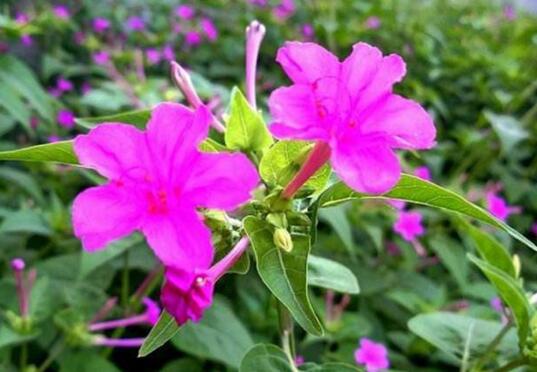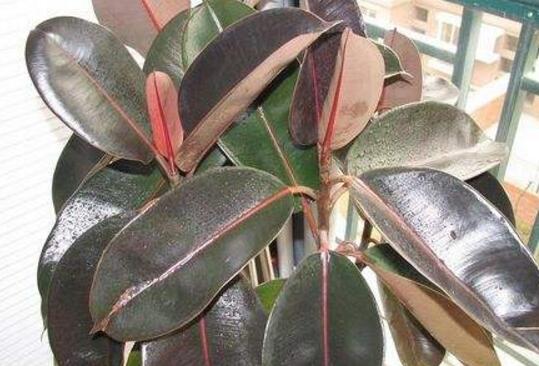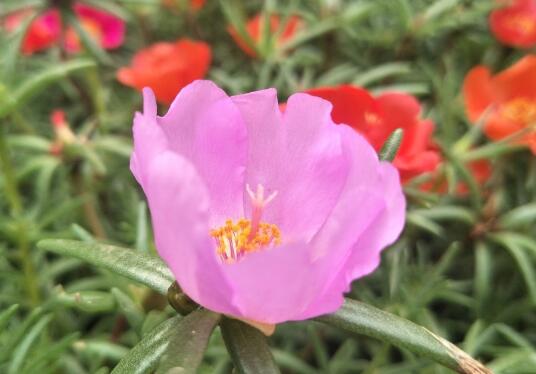How to reproduce purple jasmine? the reproduction method of purple jasmine / can be self-sown or artificially sown
We know that in the efficacy and function of purple jasmine, its roots and seeds are very useful, among which the root has the effect of clearing away heat and detoxification. The powder in the seed can dispel acne in addition to acne, in fact, in addition to these effects, they also have other uses, that is, reproduction, how to reproduce purple jasmine? Here's how to reproduce purple jasmine.
How to reproduce purple jasmine

Purple jasmine generally uses three propagation methods, namely, sowing, root tuber and cutting. its reproduction is much easier than that of other plants, especially sowing and reproduction. it can be sown artificially or reproduce by itself, just like dandelion.
The Propagation method of Mirabilis
1. Root propagation
1. Time
Before the beginning of winter, cut off the ground part of purple jasmine, then dig out the persistent root of the underground part, bury it in a flowerpot with moist soil, and put it indoors for winter. However, after the temperature rises in the spring of the second year, the persistent root will be dug up and replanted.
2. Methods
In the spring, 1/3 of the lower part of the root is planted into the potted soil, leaving the upper part of the root exposed to the soil, it will gradually stem flowers and adapt to external hallucinations, and then send out 1-2 new branches each year. These new branches will produce beautiful flowers and fruit, and the root can be cultivated for as long as ten years in this way.
2. Sowing and propagation
1. Time
Artificial sowing is usually chosen in mid-late April, so as to ensure that purple jasmine blossoms in summer and fruit in autumn, and then collect fruits to pick out full seeds. In addition, it can self-sow and reproduce after the fruit is ripe.
2. Methods
When the weather is sunny in April, sow the seeds of Mirabilis evenly on the sand bed, and then keep the temperature between 15-20 ℃. It should be noted that the seeds should not be sown on the open-field seedbed and then transplant. It usually takes 7-8 days to take root.
After rooting, you should wait until the seedlings grow 2-4 leaves before planting. When planting, you should keep a distance of 50-80 cm between the plants, then keep them in a cool place for maintenance, and do a good job of fertilization and watering according to the breeding methods and precautions of Mirabilis.
3. Cutting propagation
1. Time. Among the propagation methods of purple jasmine, cutting is one of the more commonly used methods, but the choice of time is more important, and it is generally chosen in the primary stage.
2. Methods. How to reproduce purple jasmine when using cuttings? Take buds from the sturdy branches of purple jasmine as cuttings, then insert them into the prepared substrate, which is made of a mixture of garden soil, sand, etc., then keep the temperature at 20 degrees and the substrate is moist, and can take root after 10-15 days.
How to reproduce purple jasmine? the breeding method of purple jasmine
Recently, some friends who are going to grow flowers have asked me how to reproduce purple jasmine. Is it the same as other plants? The editor here tells you that the reproduction methods of plants are different, because they are different individuals. The following editor will introduce the reproduction methods of Mirabilis in detail.
Purple jasmine flowers open in the evening to early morning, close in strong light, grow and blossom well in summer with shade, and often defoliate in the scorching sun. The sex likes the ventilation good environment, the summer has the mosquito repellent effect.
How to reproduce purple jasmine
Purple jasmine can be sown and reproduce in spring or self-sowing, usually with seeds. Using nutlet as sowing and propagation material, it can be directly broadcast in the open field in the middle and last ten days of April, the optimum temperature for germination is 15-20 ℃, and it can germinate in seven or eight days. Because it is a deep-rooted flower, it is not suitable for transplanting after sowing on the open-field seedbed. If there are conditions, it can be sowed into the tube basin with an inner diameter of 10 cm in advance, and the seedlings can be removed from the basin and planted.
Purple jasmine is propagated with seeds, and it is appropriate to sow and raise seedlings from March to April. When the seedlings grow 2-4 leaves, the plant spacing is 50-80 cm. Pay attention to shading after transplantation. Purple jasmine management is extensive, easy to grow, pay attention to proper fertilization, watering. Purple jasmine is a wind-pollinated flower, and different varieties are easy to hybridize. If you want to maintain the characteristics of the variety, you should cultivate it in isolation.
The Propagation method of Mirabilis
In the north, the aboveground part can be cut off at the end of autumn to dig up the roots and bury the fluvo-aquic soil in the flowerpot to lower the greenhouse for the winter. It will continue to be cultivated in the open field in the spring of next year, with quick mature plants and early flowering. Although the growth of persistent root plant is not as strong as that of sowing seedlings, its root tuber expands year by year, and it can grow into a brown block with a diameter of about 10 cm for 3 years.
In spring, the lower part of the root can be planted in a shallow pot, and the upper part of the root can be exposed, gradually adapting to the external environment. And inspired by the shape, constitute the natural mountain and stone bonsai. One or two new branches blossom and bear fruit every spring. Cut off the branches after autumn, put the root into the house, and keep the micro-tide of the basin soil well. If it can be cultivated continuously for decades, the root tuber will appear simple and vigorous, with unique charm.
Growing flowers is a very edifying thing. The above is some instructions on how to reproduce purple jasmine and some detailed introduction of the breeding methods of purple jasmine. I also hope that you will pay more attention to the popular agricultural materials network and learn more about agricultural information.
The culture method of how to reproduce purple jasmine
Purple jasmine is a perennial herbaceous flower whose shape is more like a trumpet. As an ornamental flower, it can be seen in many people's courtyards. Next, I will talk to you about how to reproduce purple jasmine and how to cultivate it.
How to reproduce purple jasmine
1. Sowing seeds
Purple jasmine can be sown and reproduce in spring or self-sowing, usually with seeds. Using nutlet as sowing and propagation material, it could be direct seeded in the open field in the middle and last ten days of April, the optimum temperature for germination was 15-20 ℃, and it germinated in seven or eight days. Because it is a deep-rooted flower, it is not suitable for transplanting after sowing on the open-field seedbed. If there are conditions, it can be sowed into the tube basin with an inner diameter of 10 cm in advance, and the seedlings can be removed from the basin and planted.
Purple jasmine is propagated with seeds, it is appropriate to sow and raise seedlings from March to April, when the seedlings grow 2-4 leaves, and the plant distance is 50-80 cm. Pay attention to shading after transplantation. Purple jasmine management is extensive, easy to grow, pay attention to proper fertilization, watering. Purple jasmine is a wind-pollinated flower, and different varieties are easy to hybridize. In order to maintain the characteristics of the variety, it should be cultivated in isolation.
2. Root tuber
At the end of autumn in the north, you can cut off the ground and dig up the roots and bury it in a flowerpot in a low greenhouse to survive the winter. It will continue to be cultivated in the open field in the spring of next year, with quick mature plants and early flowering. Although the growth of persistent root plant is not as strong as that of sowing seedlings, its root tuber expands year by year, and it can grow into a brown block with a diameter of about 10 cm for 3 years. In spring, the lower part of the root can be planted in a shallow pot, and the upper part of the root is exposed, gradually adapting to the external environment. And inspired by the shape, constitute the natural mountain and stone bonsai. One or two new branches blossom and bear fruit every spring. Cut off the branches after autumn, put the root into the house, and keep the micro-tide of the basin soil well. Can be continuously cultivated for decades, the older the root, the more simple and vigorous, unique charm.
Culture method of Mirabilis jasmine
1. Soil: it is better to choose fertile sandy and semi-sandy soil. Planting in slightly acidic soil with pH 6 to 6.5 can make the root system dense and grow healthily.
2. Watering: Jasmine is not resistant to drought, but avoid stagnant water. In summer, hot and sunny days should be watered twice a day, once in the morning and evening, if the leaves are found to curl and droop should be sprayed on the leaves to promote growth, the rainy season should often loosen the soil, so that there is no water in the basin.
3. Lighting: Jasmine is fond of inflammation, heat, humidity, ventilation and breathable environment, which requires sufficient light. Jasmine is a light-loving plant, its growth and development needs sufficient light, and long-day direct light is more beneficial to its growth and development. Strong light, thick green leaves, stout branches, many buds, good coloring and high aroma; if the light is insufficient or too shaded, the leaves are light green and the leaves are large and thin.
4. Temperature: Jasmine is sensitive to temperature, which requires warm, hot and humid climate and can adapt to higher air temperature, but it is not resistant to low temperature and poor cold resistance. When the temperature is below 10 ℃, jasmine grows very slowly, even stops growing. The buds can sprout at about 19 ℃, the buds can only be conceived at more than 25 ℃, and the buds can form and develop well at 30-40 ℃.
5. Fertilization: the high temperature season in midsummer is the peak period for jasmine growth, applying more organic fertilizer and phosphorus and potassium fertilizer, such as peanut cake powder, bone powder, calcium superphosphate and multi-element flower fertilizer, twice a month.
6. Prevention and control of diseases and insect pests: Jasmine is often harmed by borer larvae, shell insects and red spiders, which is the most serious from July to September. It often eats flower buds and can be sprayed with universal powder or permethrin plus water 200 times, once every semimonthly.
7. Pruning: Jasmine grows very fast in summer and should be pruned in time. Potted jasmine pruning to retain the base 10 cm to 15 cm promotes the growth of most sturdy new shoots. If the new shoots grow very vigorously, they should pick the heart when growing 10 cm and promote secondary shoots, then they will bloom more and the plant shape is compact. After the flower withered, the flower branches should be cut off in time to reduce the consumption of nutrients, but also promote the growth of new shoots, so that the branches are dense, buds are more, and flowers are more.
8. Propagation: cutting propagation, which can be carried out from April to October. Select mature and robust branches (preferably those born in the same year), cut them into about 10 cm, remove the lower leaves, and insert them in pots with half of the sediment. Pour water and cover with plastic film to maintain high air humidity and take root in 40 to 60 days.
The above is to share with you about the purple jasmine related knowledge, I hope it can help you, more household knowledge please pay attention.
- Prev

What about the growing insects of rubber trees? pest control / conservation management of rubber trees is very important.
Rubber trees can grow vigorously and have luxuriant branches and leaves, but if they do not pay attention to conservation and management, they will grow slowly or even the trunk is thin, the leaves are withered and yellow, and they are prone to diseases and insect pests, which do great harm to the health of rubber trees. what if the rubber tree grows worms? Let's take a look at the pest control of rubber trees.
- Next

How to propagate sunflower, the method of sunflower propagation / sowing propagation / cutting propagation
Sunflower is a kind of highly ornamental flower plant, which is planted by many people in our country, but with more and more people planting it, people are more concerned about its reproduction. How to reproduce sunflower? What are the breeding methods of sunflowers? Next, the editor will take you to learn about it.
Related
- Fuxing push coffee new agricultural production and marketing class: lack of small-scale processing plants
- Jujube rice field leisure farm deep ploughing Yilan for five years to create a space for organic food and play
- Nongyu Farm-A trial of organic papaya for brave women with advanced technology
- Four points for attention in the prevention and control of diseases and insect pests of edible fungi
- How to add nutrient solution to Edible Fungi
- Is there any good way to control edible fungus mites?
- Open Inoculation Technology of Edible Fungi
- Is there any clever way to use fertilizer for edible fungus in winter?
- What agents are used to kill the pathogens of edible fungi in the mushroom shed?
- Rapid drying of Edible Fungi

